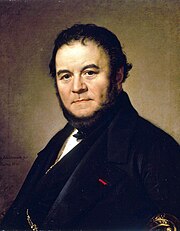Stendhal syndrome
From Wikipedia, the free encyclopedia
| This article is in need of attention from an expert on the subject. WikiProject Psychology or the Psychology Portal may be able to help recruit one. (January 2009) |
| This article includes a list of references or external links, but its sources remain unclear because it lacks inline citations. Please improve this article by introducing more precise citations where appropriate. (January 2009) |
Stendhal syndrome, Stendhal's syndrome, Hyperkulturemia, or Florence syndrome, is a psychosomatic illness that causes rapid heartbeat, dizziness, confusion and even hallucinations when an individual is exposed to art, usually when the art is particularly 'beautiful' or a large amount of art is in a single place. The term can also be used to describe a similar reaction to a surfeit of choice in other circumstances, e.g. when confronted with immense beauty in the natural world.
It is named after the famous 19th century French author Stendhal (pseudonym of Henri-Marie Beyle), who described his experience with the phenomenon during his 1817 visit to Florence, Italy in his book Naples and Florence: A Journey from Milan to Reggio.
Although there are many descriptions of people becoming dizzy and fainting while taking in Florentine art, especially at the Uffizi, dating from the early 19th century on, the syndrome was only named in 1979, when it was described by Italian psychiatrist Graziella Magherini, who observed and described more than 100 similar cases among tourists and visitors in Florence. The syndrome was first diagnosed in 1982[citation needed].
The term is often used when describing the reactions of audiences to music of the Romantic period.
[edit] References
- Graziella Magherini. La Sindrome di Stendhal. Firenze, Ponte Alle Grazie, 1989. [1]
- Frieze Magazine Article http://www.frieze.com/issue/article/the_shock_of_the_old/


